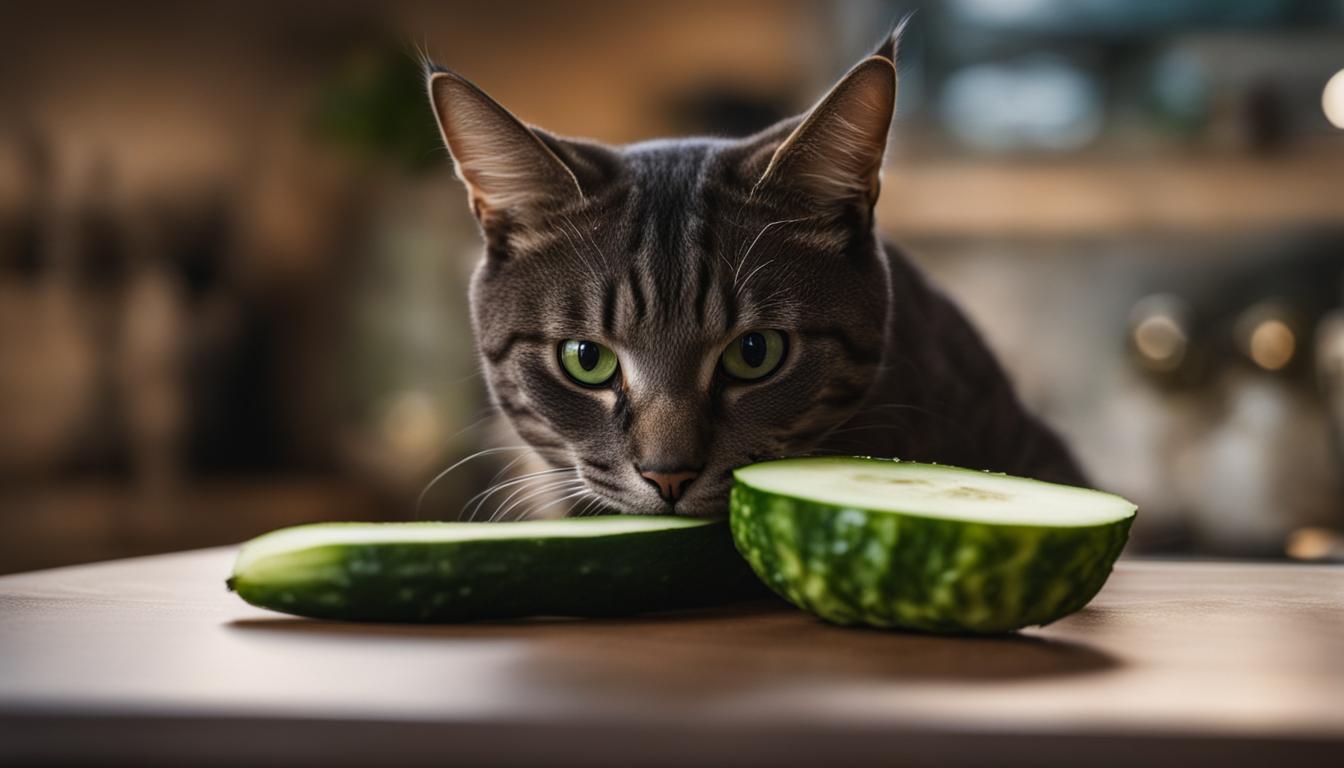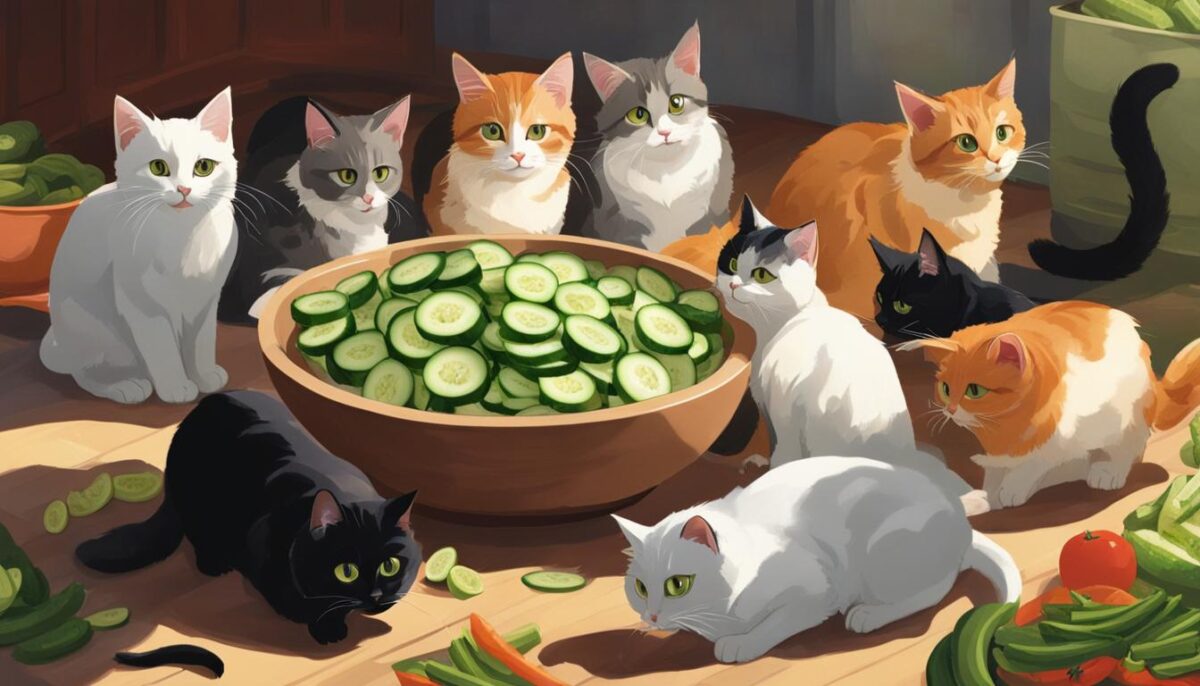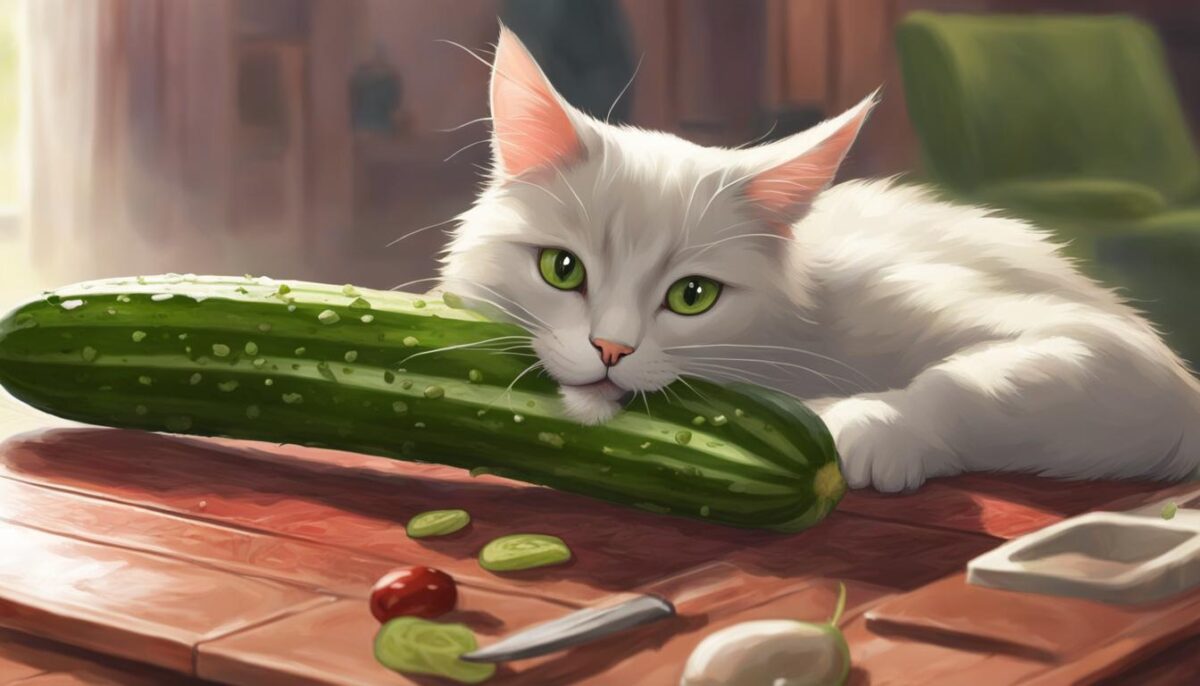Curiosity may have you wondering, can cats eat cucumbers? It’s not uncommon for pet owners to share their snacks with their feline friends. But when it comes to cucumbers, it’s important to understand if they are a safe and suitable addition to your cat’s diet.
Cats are obligate carnivores, which means their bodies are designed to thrive on a diet that is primarily made up of animal protein. While cucumbers can be given to cats as a treat or snack, they should not replace a balanced and species-appropriate diet.
Dr. Yvette Marshall, a veterinarian, recommends giving cats a slice or two of cucumber (about a quarter-inch thick) a couple of times a week. It’s important to start with a small amount to test for any allergic reactions. Cucumbers should only make up around 10 percent of a cat’s daily calories, with the rest coming from well-balanced cat food.
Key Takeaways:
- Cucumbers are safe for cats to eat, but should only make up a small portion of their diet.
- Cats are obligate carnivores, so the bulk of their nutrition should come from animal protein.
- Start with a small amount of cucumber to test for any allergic reactions.
- Cucumbers should only make up around 10 percent of a cat’s daily calories.
- The rest of a cat’s diet should come from well-balanced cat food.
How to Feed Cucumber to Your Cat
Feeding cucumbers to your cat can be a fun and healthy way to introduce a new treat into their diet. Here are some safe and creative ways to offer cucumbers to your feline friend:
- Plain cucumber: You can simply slice a cucumber into small, cat-sized pieces and offer them to your cat as a snack. This method is easy and allows your cat to enjoy the natural crunchiness of the cucumber.
- Cucumber-tuna “salad”: For a more flavorful option, you can finely chop some cucumber and mix it with a bit of canned tuna or a tuna-based wet cat food. This combination provides a tasty twist to your cat’s snack time.
- Cucumber in the water bowl: Adding a few small pieces of cucumber to your cat’s water bowl can provide a refreshing and hydrating change for them. This method is especially beneficial during warm weather when cats may need extra hydration.
- Cat-friendly “lasagna”: Layering thin slices of cucumber with your cat’s favorite wet food can create a unique and enjoyable treat. This option allows your cat to experience different textures and flavors while enjoying their meal.
Remember, when introducing cucumbers or any new food into your cat’s diet, it’s important to start with small amounts and observe for any allergic reactions. If your cat shows signs of discomfort or adverse reactions, discontinue feeding cucumbers and consult with your veterinarian.
Table: Comparison of Different Cucumber Feeding Methods for Cats
| Feeding Method | Description | Benefits |
|---|---|---|
| Plain Cucumber | Sliced cucumber pieces | Natural crunchiness, simple and easy |
| Cucumber-tuna “Salad” | Finely chopped cucumber mixed with tuna or tuna-based wet cat food | Flavorful, provides variety |
| Cucumber in Water Bowl | Add small cucumber pieces to your cat’s water bowl | Hydrating, refreshing option |
| Cat-friendly “Lasagna” | Layer thin cucumber slices with wet cat food | Different textures and flavors, enjoyable treat |
These methods allow you to incorporate cucumbers into your cat’s diet in a safe and enjoyable way. Remember to always prioritize your cat’s well-being and consult with your veterinarian if you have any concerns about their diet or health.
Health Benefits of Cats Eating Cucumbers
While cucumbers may not be a primary source of nutrition for cats, they do offer some health benefits. Here are a few reasons why you may consider giving cucumbers as an occasional treat to your feline friend:
- Cucumbers are hydrating: With their high water content, cucumbers can help keep your cat hydrated, especially if they don’t drink enough water on their own.
- Low in calories and fat: If your cat is watching their weight, cucumbers can be a suitable snack. They are low in calories and fat, making them a healthier option compared to some other cat treats.
- Nutrient-rich: Cucumbers contain vitamins and minerals such as Vitamin K, Vitamin C, Molybdenum, Magnesium, and Potassium, which can contribute to your cat’s overall health.
- Promotes dental health: The crunchy texture of cucumbers can help clean your cat’s teeth, reducing the buildup of plaque and tartar.
While these benefits are certainly appealing, it’s important to remember that cats should primarily receive their nutrition from a well-balanced cat food diet. Cucumbers should only be given as an occasional treat and not as a substitute for a complete and balanced feline diet.
| Health Benefits of Cats Eating Cucumbers | Description |
|---|---|
| Hydrating | Cucumbers have a high water content, helping to keep cats hydrated if they don’t drink enough water on their own. |
| Low in calories and fat | Cucumbers are a low-calorie and low-fat snack option for cats watching their weight. |
| Nutrient-rich | Cucumbers contain vitamins and minerals that contribute to a cat’s overall health, such as Vitamin K, Vitamin C, Molybdenum, Magnesium, and Potassium. |
| Promotes dental health | The crunchy texture of cucumbers can help clean a cat’s teeth, promoting dental health and reducing the buildup of plaque and tartar. |
“Cucumbers offer a refreshing and hydrating snack for cats, and their low-calorie nature makes them a healthier alternative to some other treats. However, it’s essential to remember that they should only be given in moderation and as part of a balanced diet.” – Dr. Yvette Marshall, Veterinarian
Can Cats Eat Cucumbers?
Yes, cats can eat cucumbers, but it’s important to introduce them gradually and in small amounts. Monitor your cat for any signs of allergies or digestive issues. As always, consult with your veterinarian before making any significant changes to your cat’s diet or introducing new foods.
Risks of Feeding Cucumbers to Cats
While cucumbers are generally safe for cats to eat, it’s important to be aware of the potential risks and considerations when including them in your cat’s diet.
Cutting cucumbers into small, manageable pieces is crucial to avoid choking hazards. Cats can have difficulty chewing and swallowing larger chunks of cucumber, so it’s important to ensure they are cut into appropriate sizes.
Non-organic cucumbers may have pesticides on their skin, which can be harmful to cats. To minimize this risk, it is recommended to use organic cucumbers or peel non-organic ones before offering them to your cat.
Cucumbers, especially the peel, contain a relatively high amount of fiber. While fiber is generally beneficial for cats’ digestion, consuming large amounts of cucumber can lead to gastrointestinal discomfort and digestive issues. It’s important to monitor your cat’s response to cucumber and adjust the serving size accordingly.
Although rare, some cats can be allergic to cucumbers. If you notice any signs of an allergic reaction such as itching, swelling, or difficulty breathing after feeding cucumber to your cat, it is essential to seek immediate veterinary care.
Overall, while cucumbers can be a safe and occasional treat for cats, it is important to consider these risks and consult with your veterinarian before adding cucumbers or any other new food to your cat’s diet.
Summary:
Cats can consume cucumbers, but precautions should be taken to ensure their safety and well-being:
- Cut cucumbers into small pieces to avoid choking hazards.
- Use organic cucumbers or peel non-organic ones to minimize exposure to pesticides.
- Monitor your cat’s response to cucumber and adjust serving size to avoid digestive issues.
- Seek immediate veterinary care if any signs of an allergic reaction occur.
By following these guidelines and consulting with your veterinarian, you can safely incorporate cucumbers into your cat’s diet as an occasional treat.
Conclusion
In conclusion, it is safe for cats to eat cucumbers, but it is important to feed them in moderation. Cucumbers can be given to cats as a treat or snack, providing some health benefits such as hydration and being a low-calorie option. However, it is essential to remember that cucumbers should not replace a well-balanced cat food diet.
When feeding cucumbers to your cat, be mindful of the potential risks involved. Cut the cucumbers into small, manageable pieces to prevent choking hazards. Consider using organic cucumbers or peeling non-organic ones to avoid exposing your cat to pesticides. Additionally, be cautious of the fiber content in cucumbers, as large amounts can cause digestive issues.
If you decide to introduce cucumbers to your cat’s diet, monitor their reaction closely. While allergic reactions to cucumbers are rare, it is important to be aware of any signs of itching, swelling, or difficulty breathing. If any of these symptoms occur, seek immediate veterinary care.
Remember, every cat is different, and what may be safe for one cat may not be suitable for another. Before introducing any new food to your cat’s diet, it is always best to consult with your veterinarian to ensure it aligns with their specific needs and dietary requirements.
FAQ
Are cucumbers safe for cats to eat?
Yes, cucumbers are safe for cats to eat, but they should only make up a small portion of their diet.
How often can I give my cat cucumbers?
You can give your cat a slice or two of cucumber a couple of times a week.
Should I start with a small amount of cucumber for my cat?
Yes, it’s important to start with a small amount to test for any allergic reactions.
How much of my cat’s daily calories should come from cucumbers?
Cucumbers should only make up around 10 percent of a cat’s daily calories, with the rest coming from well-balanced cat food.
How can I feed cucumbers to my cat?
You can offer cucumbers plain, diced into small pieces, or create a cucumber-tuna “salad” by combining finely chopped cucumber with a bit of canned tuna or tuna-based wet cat food.
Can I add cucumbers to my cat’s water bowl?
Yes, you can add a few small pieces of cucumber to your cat’s water bowl to provide a refreshing twist to their hydration.
Can I make a cat-friendly “lasagna” with cucumbers?
Yes, you can layer thin slices of cucumber with your cat’s favorite wet food to create a cat-friendly “lasagna.”
Can cats eat frozen cucumber pieces?
Yes, frozen cucumber pieces can serve as a refreshing and hydrating treat, especially in warm weather.
Can I blend cucumber with water for my cat?
Yes, blending cucumber with water to create a puree can provide extra hydration for senior cats or cats with missing teeth.
What are the health benefits of cats eating cucumbers?
Cucumbers provide hydration, low-calorie options, and potential dental health benefits for cats. They also contain vitamins and minerals like Vitamin K, Vitamin C, Molybdenum, Magnesium, and Potassium.
What are the risks of feeding cucumbers to cats?
Risks include choking hazards from large chunks or pieces, pesticides on non-organic cucumbers, digestive issues from high fiber content, and potential allergic reactions.


